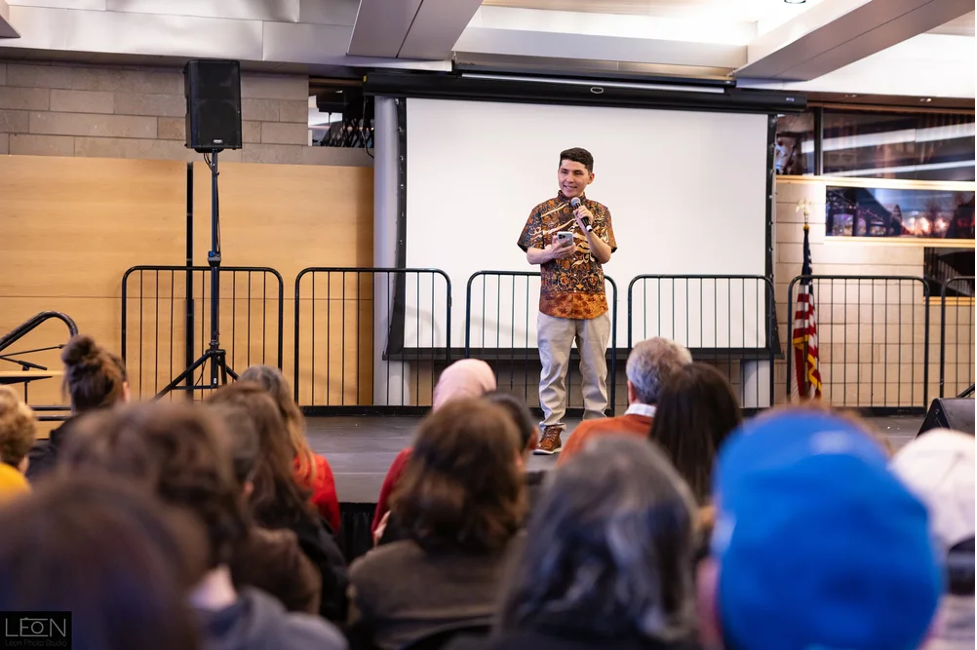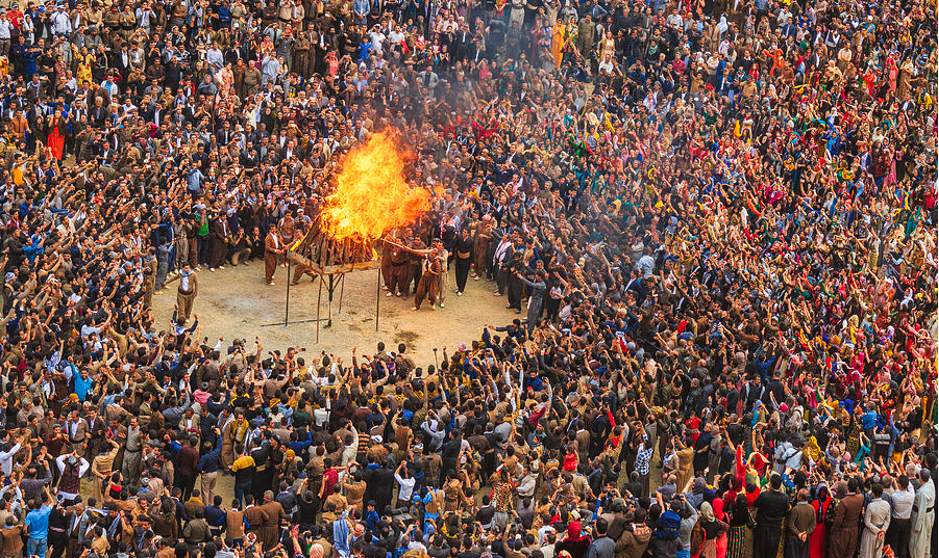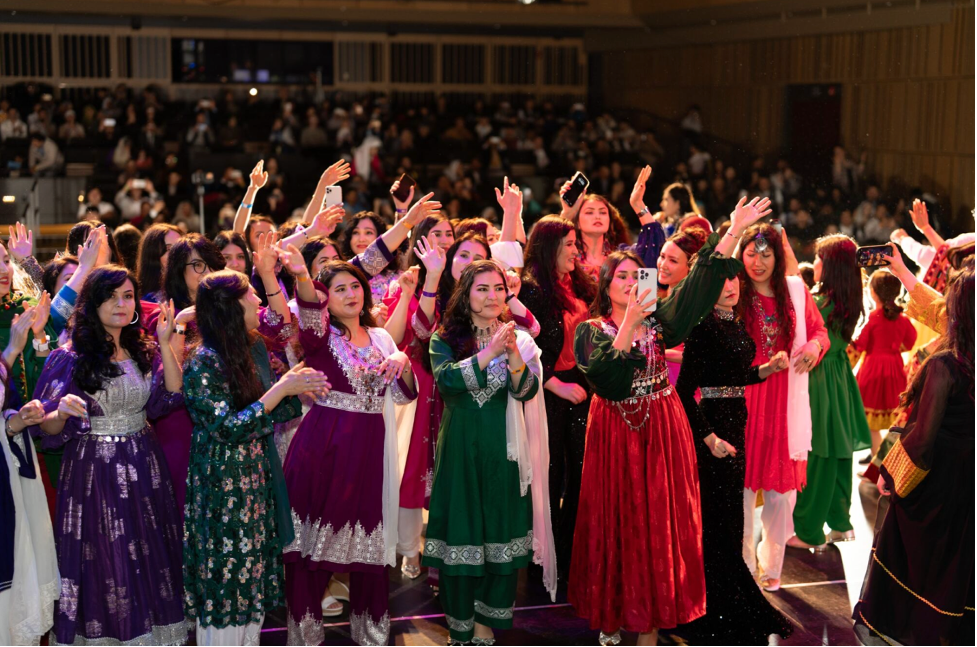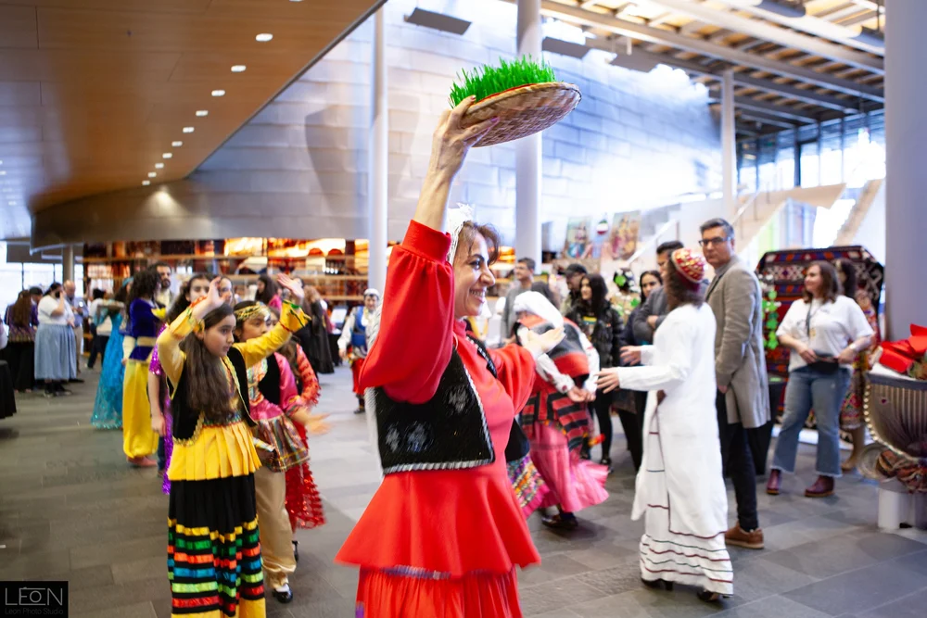Haft-Sin table at the Seattle-Isfahan Sister City Advocacy (SISCA) Nowruz celebration 2024, held at Seattle City Hall.
By: Sher Mehryar
Porsesh Policy Research Institute (PR) is undertaking a qualitative research project on Nowruz to document its cultural significance and recent history in King County. Although Nowruz has ancient roots in Central and Western Asia, its meaning continues to evolve as immigrant communities bring this tradition into their new homeland and cultural contexts. When people immigrate from different regions, they bring with them a wealth of diverse cultures and traditions. This project will explore what Nowruz is, how it is celebrated, how it has been preserved and adapted in diaspora communities here in King County, and what role it plays in fostering cultural identity, intergenerational connection, and community belonging.
The research will begin with a literature review exploring the history of Nowruz across different regions. It will also examine how immigrant communities in Western countries, including the United States, have sustained and reshaped the event. Building on this foundation, we will conduct interviews with local cultural organizations, community leaders, and scholars who host or participate in Nowruz celebrations in King County. These conversations will not only document Nowruz recent history in this region but will also gather perspectives and recommendations for how the community, local government, and future generations can continue to celebrate and preserve this heritage.
As part of the project’s public engagement, portions of these interviews will be combined with footage of Nowruz celebrations in a documentary-style video. This creative component will highlight the vitality of Nowruz while making the research accessible to a broad audience. The project will be launched in a community event on December where the research findings and documentary will be shared, providing a space for dialogue, reflection, and celebration. By documenting and preserving Nowruz in King County, this initiative seeks to honor cultural continuity, amplify immigrant voices, foster intercultural understanding, highlight King County cultural diversity, and strengthen community connections across generations.
This project is made possible in part through the generous support of 4Culture. We at PR sincerely appreciate their partnership and commitment to fostering our work and cultural diversity.
Meaning and Significance
Nowruz, literally means “new day” in Persian, is an ancient festival marking the spring equinox and symbolic of renewal and rebirth of nature. It is also the first day of the Persian new year, the calendar used in Iran and Afghanistan. Celebrated for over 3,000 years by more than 300 million people across regions such as the Balkans, the Caucasus, Central Asia, the Middle East, and beyond. According an article on UNESCO, the tradition is celebrated in all the countries that were once part of the Persian Empire.
Since 2009, Nowruz has been inscribed on UNESCO’s Representative List of Intangible Cultural Heritage of Humanity as a festivity of rich diversity promoting peace and solidarity across regions and generations (UN News). Countries that are officially part of the UNESCO multinational inscription of Nowruz are: Afghanistan, Azerbaijan, India, Iran, Iraq, Kazakhstan, Kyrgyzstan, Pakistan, Tajikistan, Turkey, Turkmenistan, Uzbekistan.

Sher Mehryar, Project Coordinator at PR and lead of this project, delivering a speech on the significance of Nowruz at the SISCA Nowruz event 2025, Seattle City Hall
In 2010, the “International Day of Nowruz” was proclaimed by the United Nations General Assembly. This Resolution welcomes the efforts of Member States where Nowruz is celebrated to preserve and develop the culture and traditions related to Nowruz, and encourages Member States to make efforts to raise awareness about Nowruz and to organize annual events in commemoration of this festivity.
The Celebration of Nowruz Across Regions and Communities
Nowruz is a festival deeply rooted in the cultural and historical heritage of many regions across the Middle East, Central Asia, and beyond. While its origins can be traced to ancient Persia[i], the celebration has transcended national boundaries, adapting to diverse cultural contexts while maintaining a shared emphasis on renewal, community, and continuity. Across Iran, Afghanistan, Tajikistan, Kurdish regions, Central Asia, and diaspora communities in Western countries, Nowruz functions as both a cultural tradition and a social institution, embodying values of unity, resilience, and identity. Despite variations in practice, the holiday symbolizes the cyclical nature of time and humanity’s enduring connection to nature.
In Iran, Nowruz is regarded as a major national holiday and is celebrated with extensive rituals and festivities. It begins at the precise moment of the spring equinox, symbolizing the renewal of nature and the turning of the year. Central to Iranian traditions is the Haft-Seen table, an arrangement of seven symbolic items beginning with the Persian letter “S,” each representing essential human values such as health, prosperity, love, and rebirth[ii]. Families prepare for Nowruz through khaneh-tekani (shaking the house/ house cleaning), the purchase of new clothing, and the preparation of special foods, all of which emphasize purification and fresh beginnings[iii]. The celebration extends over nearly two weeks, characterized by reciprocal family visits, the exchange of gifts, and communal meals. The holiday concludes with Sizdah Bedar (getting rid of thirteen/ thirteen outdoor), when families gather outdoors to enjoy nature, underscoring themes of harmony and renewal. These traditions not only reinforce family ties but also sustain intergenerational cultural continuity, making Nowruz both a personal and collective expression of identity.
Afghanistan shares many similarities with Iran in its observance of Nowruz due to their intertwined history, language, and cultural exchange. Families from Afghanistan also prepare through cleaning, decorating, and setting festive tables. However, a distinct feature of Afghanistan tradition is the Haft Mewa, a dish prepared with seven dried fruits and nuts, symbolizing renewal and abundance[iv]. In Mazar-e-Sharif, Balk province the Blue Mosque historically served as the focal point of public celebrations, most notably the Jahenda Bala ceremony, where a sacred banner was raised to symbolize unity and renewal. Nowruz festivities typically include music, dance, poetry, and kite flying, creating a vibrant communal spirit that strengthens social bonds. Yet, since the Taliban’s return to power in 2021, official celebrations have been banned. The Taliban reject Nowruz as a non-Islamic tradition and have attempted to suppress it, underscoring the tension between cultural heritage and political authority. Nevertheless, within society, the festival endures as a meaningful tradition that connects communities to their past and to each other.
In Tajikistan, Nowruz is both a cultural and state-recognized holiday celebrated on the spring equinox. Festivities include home preparations, family gatherings, and the preparation of traditional foods, particularly sumalak, a sweet paste made from sprouted[v]. Public celebrations feature music, dance, poetry readings, and traditional sports, such as wrestling and goat-carcass polo (buzkashi), that bring together communities in both urban and rural settings. By serving as both a familial and a national occasion, Nowruz in Tajikistan underscores the link between cultural continuity and state identity. Its widespread observance demonstrates how ancient rituals can be integrated into modern national life, sustaining values of renewal and solidarity.
Among the Kurds, Nowruz carries profound cultural and political significance. Beyond its seasonal symbolism, it is closely associated with the legendary tale of Kawa the Blacksmith, who overthrew a tyrant and lit bonfires to signal liberation. In contemporary celebrations, bonfires remain central, with families and communities gathering around flames, often jumping over them as acts of purification and hope. Kurdish festivities also include traditional dress, music, and dancing, marking the holiday as an affirmation of cultural pride, resilience, and unity. For Kurdish communities, Nowruz is not only the start of spring but also a symbolic assertion of freedom, identity, and aspirations for justice[vi].
 Nowruz in Kurdish region. Photograph by Babak Mehrafshar
Nowruz in Kurdish region. Photograph by Babak MehrafsharElsewhere in Central Asia and the Caucasus, Nowruz has been widely institutionalized as a cultural and national holiday[vii]. In Azerbaijan, households prepare special meals and take part in public performances and games, while in Turkmenistan, community feasts and festive dishes emphasize unity and social ties. In Uzbekistan, Nowruz involves preparing sweets, visiting relatives, and enjoying outdoor festivities marked by music, dance, and sports. Although the details vary across these societies, the overarching themes of renewal, family, and social harmony remain consistent. Nowruz thus serves as a regional cultural thread, uniting diverse nations through shared practices and values.
Among diaspora communities in Western countries, Nowruz continues to thrive as a means of cultural preservation and adaptation. Families often set up Haft-Seen tables, prepare traditional foods, and gather with relatives and friends. Cultural organizations and community centers play a vital role in organizing public events that include music, dance, poetry, and storytelling, introducing Nowruz to wider audiences while strengthening bonds within immigrant communities. For younger generations born abroad, these celebrations provide a connection to their cultural roots, fostering intergenerational identity and belonging. Though celebrated on a smaller scale compared to the countries of origin, Nowruz in the diaspora reflects both resilience and adaptability, serving as an introduction to host communities while sustaining cultural pride and integrating into multicultural societies.
 Nowruz event organized by Hazara Community of Washington 2025. Photo by: Yari
Nowruz event organized by Hazara Community of Washington 2025. Photo by: YariOverall, Nowruz is more than a seasonal celebration of spring; it is a living cultural tradition that embodies themes of renewal, identity, and continuity. Across Iran, Afghanistan, Tajikistan, Kurdish regions, Central Asia, and the diaspora, it functions as both a personal and collective ritual that strengthens social ties, affirms cultural pride, and bridges past and present. Despite political challenges and regional variations, Nowruz endures as a festival that unites diverse peoples across vast geographies, reflecting a shared heritage while embracing local meanings. In this way, Nowruz illustrates the capacity of cultural traditions to adapt, persist, and remain vital across time and space.
Nowruz and Religions
Nowruz is often described by its celebrants as a secular and natural holiday that transcends religious boundaries. Many from the Nowruz region emphasize with pride that, unlike Christmas, it is not formally tied to a single faith but instead belongs to humanity as a commemoration of seasonal renewal and arrival of spring. Nevertheless, the history of Nowruz reveals a far more complex relationship with religion. Over centuries, it has been shaped by diverse religious traditions, suppressed by some authorities, and reinterpreted by others. While it has no direct or exclusive connection to Islam, its pre-Islamic roots have made it the subject of both criticism and accommodation. At the same time, Nowruz retains enduring ties to Zoroastrianism, the ancient faith of Persia, from which many of its symbolic and ritual dimensions originate.
The connection between Nowruz and Zoroastrianism is particularly evident in its cosmological symbolism. The transition from winter to summer mirrors the Zoroastrian dualistic worldview that conceives of existence as a battle between good and evil[viii]. Likewise, the joyful celebration of spring can be read as a reflection of Zoroastrian eschatology, which envisions the eventual triumph of good and the restoration of the world to an original state of harmony. Today, Zoroastrian communities such as the Parsis of western India continue to observe Nowruz as a time of spiritual renewal, underscoring the holiday’s ongoing religious resonance.
Persian literary tradition has also preserved the cultural and mythological significance of Nowruz. In Ferdowsī’s monumental epic, the Shāh-nāmeh (“Book of Kings,” c. 1010 CE), the festival is attributed to the mythical King Jamshīd (Yima in Avestan texts). According to this account, Jamshīd, after bringing prosperity and civilization to his people, ascended into the heavens on a jewel-encrusted throne. The day of this exalted event was declared Nowruz, the “new day,” embedding the festival within both mythology and national identity.
Despite the Arab Muslim conquest of the Sasanian Empire in the seventh century, Nowruz survived as a vital cultural practice. Although Zoroastrian political authority was displaced, Persians continued to celebrate the holiday, which was gradually incorporated into the life of Islamic dynasties such as the Samanids and Buyids. Later Turkic and Mongol rulers further embraced the festival, spreading it across Central Asia[ix]. Its persistence illustrates the adaptability of Nowruz within changing religious and political contexts.
Islamic scholars responded to Nowruz in divergent ways. Some early caliphs and theologians condemned the holiday as a remnant of pagan custom, while others sought to integrate it into Islamic tradition.[x] Certain hadiths depict the Prophet Muhammad accepting a Nowruz gift, other traditions/narrative attributed to Jaʿfar al-Ṣādiq, the sixth Shiʿi imam, ascribe cosmic and theological significance to the festival. These narratives link Nowruz to key moments in sacred history, from the covenant of monotheism to the destruction of idols in Mecca, and even to the final resurrection. Such reinterpretations allowed Nowruz to gain legitimacy within Islam, particularly among Shiʿi communities (Britannica, Nowruz).
In the modern period, the religious and political contestation of Nowruz has continued. Since the 1979 Iranian Islamic Revolution, clerical leaders have sought to diminish the festival, framing it as a Zoroastrian custom incompatible with Islamic orthodoxy. Yet their efforts have largely failed, as Iranians continue to embrace Nowruz as a cherished cultural tradition, with some even viewing it as a form of quiet resistance to theocratic authority. Similarly, the Taliban in Afghanistan have attempted to suppress Nowruz as un-Islamic, but local communities persist in marking the day, often in private or clandestine gatherings.
Elsewhere, Nowruz has faced suppression under different ideological frameworks. During the Soviet era, it was banned in Central Asia on the grounds that it was a religious festival, deemed incompatible with communist anti-religious policies. With the dissolution of the Soviet Union in 1991, however, Nowruz reemerged as a central cultural celebration. Today, it is publicly observed in Azerbaijan, Kazakhstan, Kyrgyzstan, Tajikistan, Turkmenistan, and Uzbekistan, each country adapting the holiday to its own national and cultural identity.
 Photo from the SISCA Nowruz celebration at Seattle City Hall 2025
Photo from the SISCA Nowruz celebration at Seattle City Hall 2025Taken together, these histories reveal the remarkable resilience of Nowruz across religious and political transformations. From its Zoroastrian origins to its reinterpretation in Islamic contexts and its revival after state suppression, Nowruz illustrates the dynamic interplay between religion, culture, and politics. Far from being a purely secular or purely religious festival, it is best understood as a living tradition that has continually negotiated its meaning within changing historical circumstances.
Gaps in Research
While Nowruz has been extensively studied in its countries of origin, including Iran, Afghanistan, Tajikistan, and among Kurdish communities, there is a notable lack of research examining the celebration of Nowruz among immigrant populations in Western countries. In particular, King County, with its growing Afghan, Iranian, and Central Asian diaspora, has not been the focus of any systematic study documenting how Nowruz is observed, adapted, and transmitted across generations. Existing scholarship tends to emphasize historical practices, national rituals, or political dimensions of Nowruz in home countries, leaving the experiences of diasporic communities underexplored.
This qualitative study seeks to address this gap by documenting the recent history and contemporary practices of Nowruz celebrations in King County. By conducting interviews with cultural scholars, community leaders, and participants in Nowruz events, this research seeks to capture both the symbolic and practical significance of the festival for immigrant communities, while promoting intercultural understanding and documenting King County’s cultural landscape. The study will examine how traditions are maintained, transformed, and communicated within a multicultural context, shedding light on issues of cultural continuity, identity formation, and intergenerational transmission. In doing so, this research will contribute to a more comprehensive understanding of Nowruz as a living cultural practice that bridges homeland heritage and diasporic life.
Stay tuned! For collaboration opportunities on this project, please contact Sher Mehryar at info@prresearch.us
[i] D’Onofrio, S. (2018, December 21). Nowruz: The seeds of a new day. UNESCO Courier. https://courier.unesco.org/en/articles/nowruz-seeds-new-day
[ii] Shahbazi, A. S. (2002, December 15). Haft Sin. Encyclopaedia Iranica, 11(5), 524-526. https://www.iranicaonline.org/articles/haft-sin/
[iii] Preston, C. (2025, August 8). Nowruz. Encyclopædia Britannica.
https://www.britannica.com/topic/Nowruz
[iv] Sharifi, M. (2019). The Nauroz festival as a social site: understanding faith, ethnicity and nation-ness in Afghanistan. Boston University
https://open.bu.edu/items/b98129c4-66c2-4bdd-90d3-096e912770f7
[v] Dodkhudoeva, L., Yusufbekova, Z., & Shovalieva, M. (2019). National festivals of the Tajiks through the ages. University of Central Asia, Cultural Heritage & Humanities Unit. https://ucentralasia.org/media/s22fgoai/chhu-rp-4-eng.pdf
[vi] Khalid, H (2020). Newroz from Kurdish and Persian Perspectives – A Comparative Study. Journal of Ethnic and Cultural Studies.
https://www.ejecs.org/index.php/JECS/article/view/318?articlesBySimilarityPage=11
[vii] Shabahang, M. (n.d.). Nowruz: Celebrating the New Year on the Silk Roads. UNESCO Silk Roads Programme.
https://en.unesco.org/silkroad/content/nowruz-celebrating-new-year-silk-roads
[viii] Boyce, M. (2000, January 1). Nowruz i. In the pre-Islamic period. In Encyclopaedia Iranica. https://www.iranicaonline.org/articles/nowruz-i/
[ix] The Editors of Encyclopaedia Britannica. (2025, August 8). Nowruz. Encyclopaedia Britannica. https://www.britannica.com/topic/Nowruz
[x] Shahbazi, A. S. (2000, January 1). Nowruz ii. In the Islamic period. Encyclopaedia Iranica. https://www.iranicaonline.org/articles/nowruz-ii

